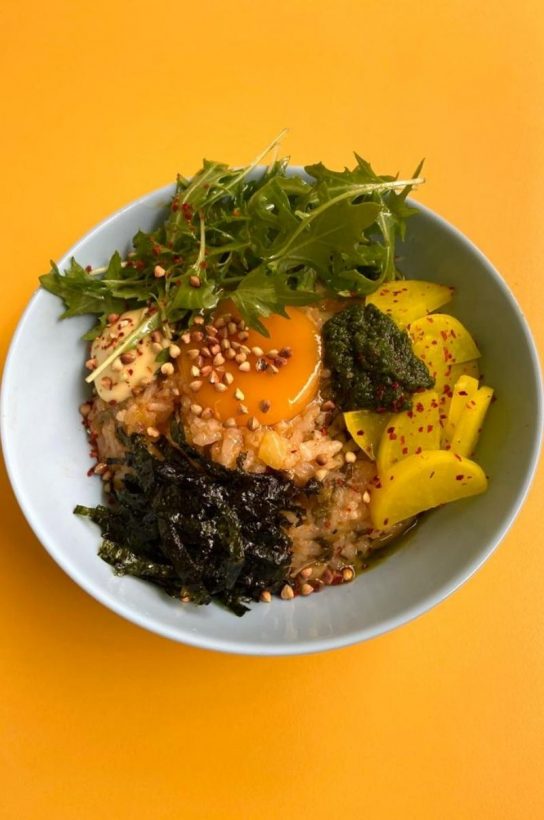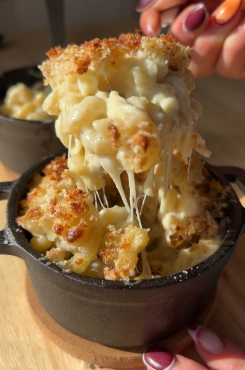Staff meal: Freddie Janssen of Snackbar kimchi fried rice recipe
Published 17 May 2021
by Freddie Janssen

Snackbar in Dalston is known and loved for the vibrant, delicious dishes created by chef-patron Freddie Janssen. During lockdown she created fantastic food to-go and now that dining in is back, she’s bringing her team together. Here she shares her recipe for a real Snackbar favourite, kimchi and pineapple fried rice
Rice and pickles. They’re my go-to snack mid-service, and they’re always the part of our favourite staff meal at Snackbar. We always have a big rice cooker steaming away in the kitchen, and if there’s any left over after service we turn it into either onigiris (rice triangles that we fill with pickles and wrap onigiris (rice cake triangles that we fill with pickles and wrap with seaweed), a rice bowl with curry sauce and pickles, and, if there’s still some left over we save it for the next day and turn it into kimchi fried rice.
We always have a plethora of pickles, ferments and sauces kicking around, and as they’re mini flavour bombs they go a long way and we top the rice bowl with them!
The vegan kimchi and pineapple rice is a big a fave – we make it with wild garlic pesto, pickled daikon, mizuna salad with lemon kosho dressing, nori, buckwheat. We throw an egg yolk on top for the non-vegan staff so they get an extra protein kick!
KIMCHI FRIED RICE
Ingredients (serves four)
2 cups cooked sushi rice
2 tbsp olive oil
1 tbsp light soy sauce
100g kimchi, chopped with juice
200g pineapple, diced
Optional ingredients:
Wild garlic pesto
Pickled daikon
Sriracha mayo
Mizuna salad
Egg yolk
Nori (shredded, powdered, sheets, any shape or form)
Toasted buckwheat
Gochugaru
Plus anything pickle-y, ferment-y, mayo-y and tasty you have in your fridge. Go wild!
Method
Combine the kimchi and pineapple in a bowl and let them hang out and get to know each other for a while.
Put the olive oil and soy sauce in a sauce pan on moderate heat. Add the kimchi and pineapple. Add the cooked rice and keep tossing until its fragrant and a little crunchy. Throw them into a bowl and put all your favourite toppings on it!
VEGAN KIMCHI
Ingredients
2 large Chinese cabbage, 600g-700g each
2 tbsp sea salt
100g + 2 tbsp sugar
3.5 tbsp gochugaru
3 garlic cloves, microplaned
6cm ginger, microplaned
60ml light soy sauce
50ml sesame oil
6 spring onions, chopped
3 tbsp white sesame seeds
Method
Rinse the cabbage well and drain. Chuck out any damaged outer leaves.
Slice the cabbage in half, then cut it into 4 pieces lengthways. Next, chop the cabbage into slices about 1 cm thick.
Put the cabbage into a large plastic container and add the salt and 2 tablespoons sugar. Toss well, put the lid on the container and chill in the fridge for 24 hours.
Remove the cabbage from the fridge. (Ideally, you want to do this an hour before handling it to keep your hands from getting super cold.) Take handfuls of cabbage, and squeeze out as much of the liquid as you can.
In a separate bowl or plastic container, add the gochugaru, the remaining sugar, garlic and ginger and mix well. Add water if it’s too thick, then stir in the soy sauce and sesame oil.
Add the cabbage, spring onion and sesame seeds to the slurry and use your hands to mix really well, squeezing the paste into the cabbage. (I recommend you wear some gloves for this). Return the cabbage to the large plastic container, put on the lid and refrigerate.
The kimchi will taste nice within 1 week, and start to build up a nice funk after 2 weeks. After those 2 weeks you can keep fermenting it as it will just get fizzier and funkier. This will keep for up to 1 month.
For more articles from the latest edition of the CODE Quarterly magazine, click here




